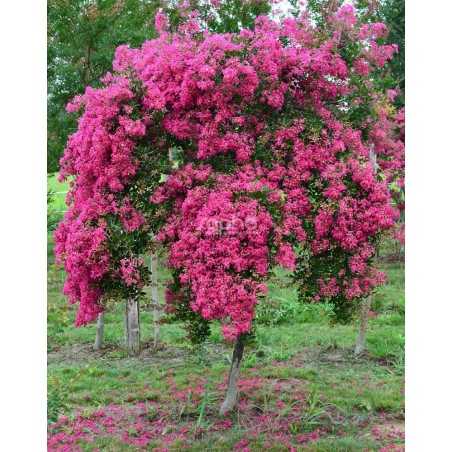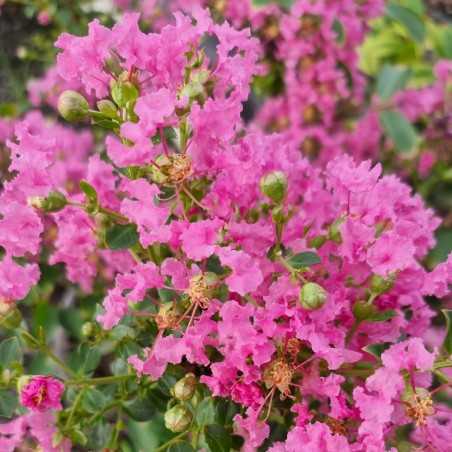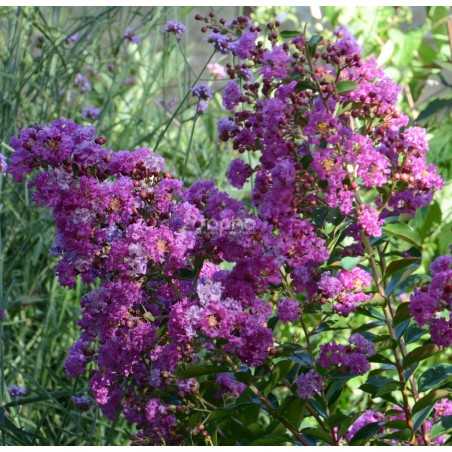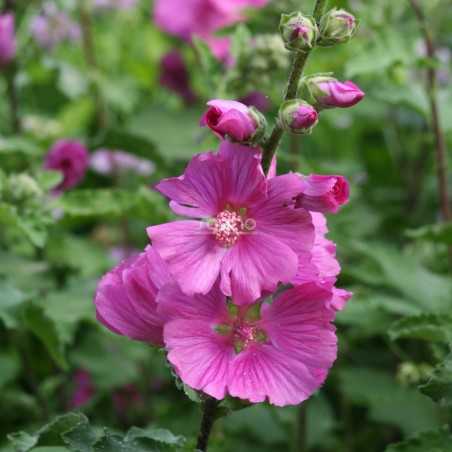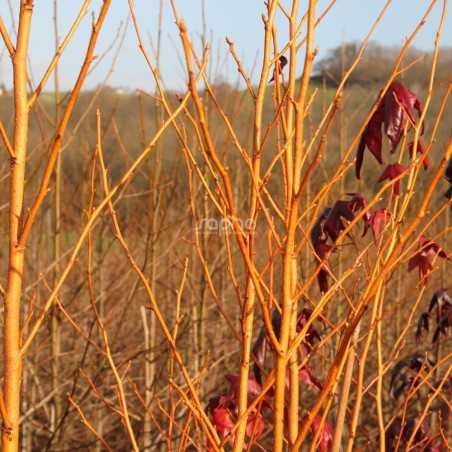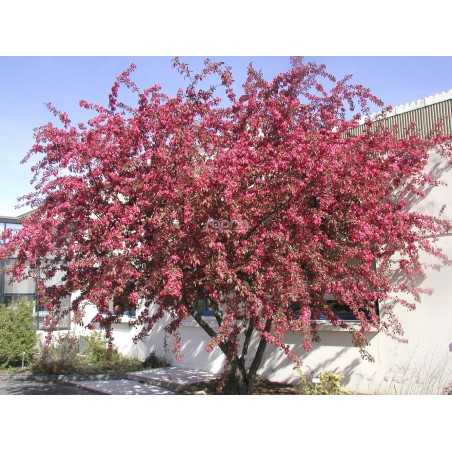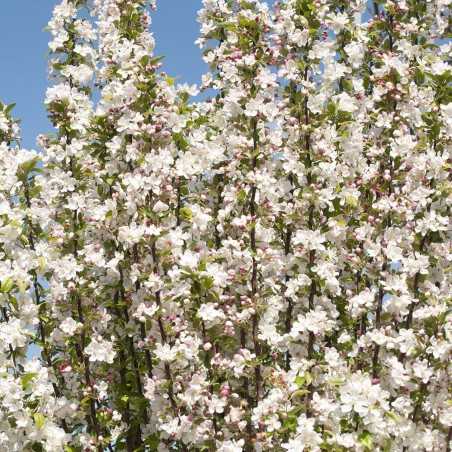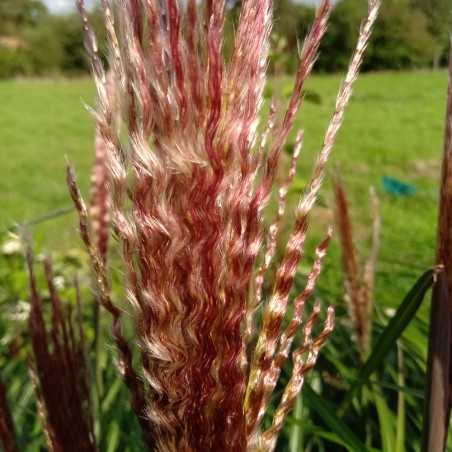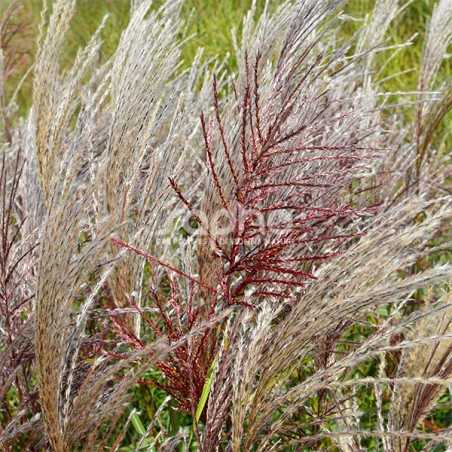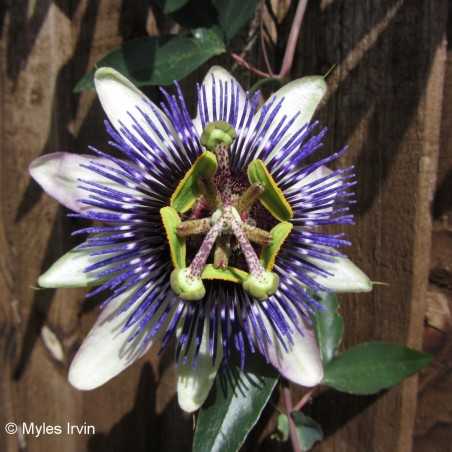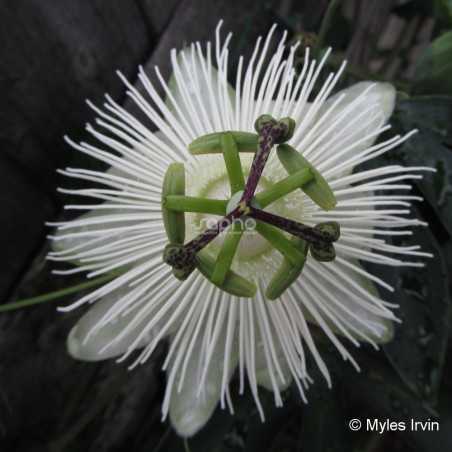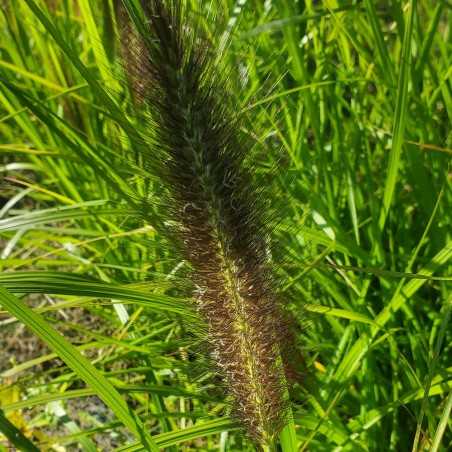MIMIE® Fuchsia: covering growth, prolific bright flowers, early and long lastingThis Lagerstroemia variety bred by Alain DABADIE had firstly been chosen for its growth as carpeting ground cover or weeping if the plant is stem trained. The cultivation takes on this shape naturally, without pruning. Further on, MIMIE® Fuchsia 'DABLAGE01' is floriferous right from its early age. It blooms precociously and continues all summer long producing successive new flowers. The 4 cm long florets in the form of remarkable raspberry red grapes can reach up to 30 cm. The flowering season is from mid June to mid October; these dates vary according to the climate.Finally, this cultivation only needs little or no maintenance. It is a healthy plant, no sensitivity to powdery mildew has been noticed. The novel shape, the precocity, the duration of the bright coloured flowers, it all allows an original use of the crape myrtle, and this even in a wide climatic zone. MIMIE® Fuchsia has its place as ground cover or, when grown as a small standard, is particularly considered for balconies and terraces and at last, more traditionally, in bushy clumps.Trophies: Silver medal at Innovert® 2017 nursery category (Nantes - FRANCE).
Filter By
Foliage
Position
Categories
Menu
All our varieties
The qualities of MIMIE® Fuchsia lagerstroemia in a pink version
MIMIE® Rose lilac is a compact variety with a horizontal habit, ground-covering or weeping if trained as a stem.
It blooms pink early and remontant all summer long. Its foliage is bright green with a smooth texture.
It is perfect for planting in the ground, as an isolated specimen, in a bed or in a pot, on a terrace or balcony.
Bright violet in the INDIYA CHARMS® range
This strong growing variety offers early very bright violet flowers, contrasting with the gold-yellow stamens.BRAISE D'ÉTÉ®, CAMAÏEU D'ÉTÉ®, FUCHSIA D'ÉTÉ® and VIOLET D'ÉTÉ® are the four varieties of the INDIYA CHARMS® range of our program. They offer pretty shades of mauve, violet, pink and red, adding bright summer colours to shrub borders and mixed hedges. Stem-grafted, in pots or in the ground, they decorate any entrance, terrace or, more traditionally, can be planted in a row.They can also be trained along a south facing wall.
Trophies:
Bronze medal at Plantarium 2013 (Boskoop - NETHERLANDS)
A bright lavatera for the beginning of summer.Deriving from the Lavatera olbia 'Rosea', CHAMALLOW® shows a certain orginality compared to the classic varieties of Lavatera. This selection has a particularly compact, bushy and rounded growth. Its light green, slightly velvety foliage stays healthy. These qualities make it interesting for growing in containers.In July - August, the straight branches have deep pink flowers. They are of medium size with even darker pink stripes.To be planted in flowering hedges or in beds, together with shrubs and perennials.
A Liquidambar, bright even in winter.
This tree, which is very original due to its yellow wood, contrasting with its red stalks, is decorative in winter.
Its deciduous foliage, pale yellow in the spring, then green in summer, changes to remarkable red tones in the autumn.
Due to the speed of its medium growth, 'Golden Sun' is a small tree, with an identical shape to the classic American sweet gum tree: even pyramid, with lateral branches growing regularly out of the trunk.
It is as suitable individually grown in smaller gardens, as in rows.
An ornamental apple tree for the town or the country.This tree is of semi-spreading shape, reaching a height of 3 to 4meters in ten years and has a harmonious form, which it keeps without the necessity of pruning. Its leaves and branches are purple.The violet-pink flowers blossom in April - May along the whole length of the branches, and the purple fruits appear in autumn.COCCINELLA® has also been chosen by the INRAE selectors for its resistance to the major diseases such as fire blight, scab and mildew.Grown to a full standard, COCCINELLA® has the asset of a small town tree; grown in clumps, its foliage and fruit are appreciated in mixed countryside hedges or in shrub borders.
Naturally a STAR since its creation.
This tree is of semi-spreading growth, reaching a height of 3 to 4m in ten years and has a harmonious shape, which it keeps without the necessity of pruning. Its foliage is green.
In April, 'Evereste' covers itself in bright pink flower buds, which bloom as pure white bouquets of flowers. The quality and the abundance of its pollen make it an ideal pollinator, precious for fruit growers (in proportion of 6 - 8% of all varieties of early or semi-early flowering).
The cherry sized fruits are orange with thin red stripes. They apprear in autumn and have the particularity to last well into winter.
'Evereste' has also been chosen by the INRAE selectors for its resistance to the major diseases such as fire blight, scab and mildew.
Nearly a million plants have been sold in Europe since its creation in 1974.
Its ornamental qualities, its reasonable dimensions and its easy care make it an excellent small urban tree if grown full standard; in clumps it is very valuable in the composition of flowering hedges and in shrub borders.
A flamboyant Miscanthus in late summer
This grass has red flowers with pink highlights, appearing in summer and providing a superb contrast to its dark green foliage with silvery-white stripes.
In autumn, the colors of the stems and foliage change to reddish tones.
It's a strong, vigorous plant, with dense branching from an early age.
It can be used as an isolated plant, in a bed or as a plant screen.
A beautiful red autumn colour that lasts until the coldest weather
This grass has a red spike-like bloom that appears in summer, contrasting with its green, white-ribbed foliage.
In autumn, the foliage and stems take on an intense, long-lasting reddish hue.
Miscanthus can be used in the ground, as an isolated plant, in a bed or as a plant screen.
Walls, trellises and pots : big decorative flowers from May to the frosts
Vigorous and spectacularly climbing, this polyploid hybrid attaches itself thanks to its tendrils.
Evergreen in mild winter regions, semi evergreen in colder areas, it must be protected at temperatures of under -8°C.
The leathery foliage, made up of 3 to 5 lobes with pronounced veins, is shiny and of an attractive dark green.
From May until the frosts several flowers appear daily. They can reach 13 cm in diameter, have a white corolla with shades of lilac and the filament crowns are beautifully dark violet purple and blue. The scented flowers last several days.
Fruits are rare.
Very decorative during the whole summer, RIVERSIDE® 'Damsel's Delight' covers walls and trellises and can also be pot-grown.
Walls, trellises and pots : a graphic passion flower from May to the frosts
Vigorous and spectacularly climbing, this polyploid hybrid attaches itself thanks to its tendrils.
Evergreen in mild winter regions, semi evergreen in colder areas, it must be protected during temperatures of under -8°C.
The large foliage, formed of 3 to 5 lobes with pronounced veins, is shiny and of an attractive dark green.
From May until the frosts several flowers appear daily. They can reach 12 cm in diameter and surprise us with their pure white petals, sepals and filament crowns. The 5 green stamens and the 3 dark stigmata stand out well from the white. The scented flowers last several days. They are followed by decorative, non-edible yellow-orange fruits of about 6 cm.
Very decorative and graphic during the whole summer, RIVERSIDE® 'Snow Queen' decorates walls and trellises and can also be grown in pots.
Charming black panicles contrasting with a green foliage
This variety of pennisetum has large, red-tinged spikes that turn purple-black.
The spikes appear abundantly, covering the entire plant from summer to late autumn.
It forms a rounded clump with narrow, glossy green foliage.
Use in beds, in association with other perennials or shrubs.

